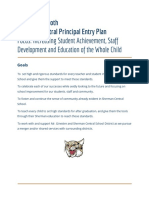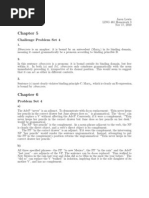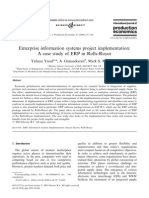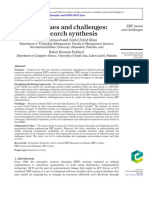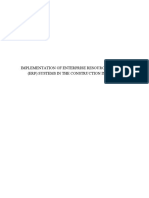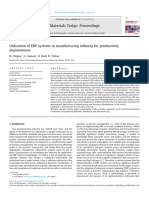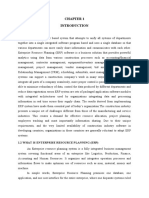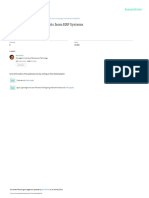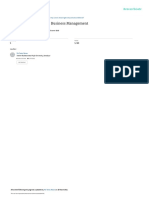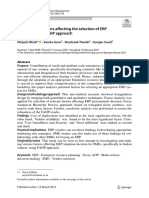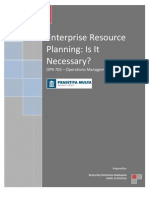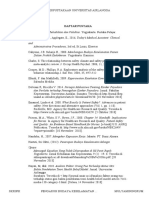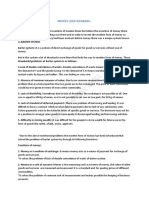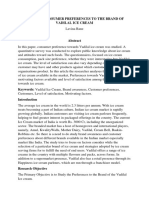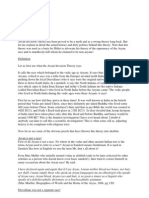ERP Implementation in The Project-Based Organizations of The Construction Industry
ERP Implementation in The Project-Based Organizations of The Construction Industry
Uploaded by
AYUSHNEWTONCopyright:
Available Formats
ERP Implementation in The Project-Based Organizations of The Construction Industry
ERP Implementation in The Project-Based Organizations of The Construction Industry
Uploaded by
AYUSHNEWTONOriginal Title
Copyright
Available Formats
Share this document
Did you find this document useful?
Is this content inappropriate?
Copyright:
Available Formats
ERP Implementation in The Project-Based Organizations of The Construction Industry
ERP Implementation in The Project-Based Organizations of The Construction Industry
Uploaded by
AYUSHNEWTONCopyright:
Available Formats
See discussions, stats, and author profiles for this publication at: https://www.researchgate.
net/publication/282672266
ERP implementation in the project-based organizations of the construction
industry
Article · March 2014
CITATIONS READS
0 2,679
1 author:
Khalid Almarri
British University in Dubai
20 PUBLICATIONS 98 CITATIONS
SEE PROFILE
Some of the authors of this publication are also working on these related projects:
Public private partnerships View project
All content following this page was uploaded by Khalid Almarri on 09 October 2015.
The user has requested enhancement of the downloaded file.
The Business & Management Review, Volume 4 Number 4 March 2014
ERP implementation in the project-based organizations of the
construction industry
Khalid Al Marri
The British University in Dubai (BUID), United Arab Emirates
Keywords
Enterprise Resource Planning (ERP), Knowledge Management (KM); Project-based
Organisations (PBO)
Abstract
To achieve a competitive advantage within the project-based environment, businesses must
employ the state of the art technologies to survive the competition. Technologies such as enterprise
resource planning in conjunction with the knowledge management process can help reduce redundancy,
minimize cost, integrate operations, and improve quality.
This report introduces ERP as a solution to the problems identified as weaknesses in project
tracking, resource management, and decision-making of project-based organizations in the construction
industry. The implementation of an ERP system along with improving the knowledge management
infrastructure at these organizations will enable the them to realize many benefits through improving
their products, cutting costs, and gaining real time information needed for an effective decision making
process.
To support the use of ERP and the improvement of KM infrastructure, two case studies will be
presented. The findings of these case studies will be re-used to suggest solutions for the PBO to gain
similar outcomes. Three alternatives of ERP systems from SAP, Oracle, and Microsoft will be introduced
with their respective merits.In addition to the re-used alternatives, an additional alternative, C-ERP will
be recommended. The merits of this option will be detailed to allow for establishing a direct link to the
scope of the construction PBO.
Finally, a four-stage implementation plan for PBO will be introduced, in addition to a six-phase
implementation plan for the vendor to complete the installation and commissioning of the system.
1. Introduction
To achieve a competitive advantage within the project-based environment, businesses
must employ the most advanced technologies to survive the competition. Such technologies
help reduce redundancy, minimize cost, integrate operations, and improve quality. The need to
integrate organizational processes and exchange knowledge effectively and efficiently between
all stakeholders necessitated on most businesses the implementation of enterprise resource
planning technology. The successful implementation of ERP systems can develop an effective
integrated and shared data system that can link all departmental scopes of the organization.
Some of the key benefits of the implementation of ERP systems are reduced working capital, the
ability to integrate departmental services, and the availability of real time information about all
processes (Xu et al., 2006).
The implementation of an ERP system along with improving the knowledge
management infrastructure at any project-based organization will enable the company to realize
International Conference on Business and Economic Development (ICBED), New York-USA 13
The Business & Management Review, Volume 4 Number 4 March 2014
an abundance of benefits through improving its products, cutting its costs, and gaining real time
information needed for an effective decision making process.
Report Structure
The remaining sections of this report will be structured as follows: Section two will
introduce the problems related to knowledge management in PBO, the introduction of the
relationship between ERP and KM, and lastly the impact of their integration. Section three will
be about the identification of the problems faced by PBO in the construction industry in relation
to knowledge management. Section four will introduce alternatives adopted from two
international best practices. Section five will provide recommendations based on the proposed
alternatives and their suitability to responding the problems faced by the PBO. Finally, the last
section will provide a tentative implementation plan where all phases will be detailed, the time
frame will be proposed, and the associated costs will be highlighted.
2. Problem identification and analysis
Knowledge management and enterprise resource planning
“ERP implementation is closely related to knowledge management. Although
technology by itself is not knowledge management, knowledge management is often facilitated
by the human who uses technology” (Li and Zhao, 2006). ERP systems are widely adopted and
implemented nowadays since the platform can help enterprises gain a competitive advantage
over their rivals and improve their performance (Xu et al., 2006). At the same time there is a
high recognition of the vital role knowledge management plays in the success of these
enterprises. In general, there are two types of assets in any enterprise, physical and knowledge
assets.
ERP systems are concerned with managing the physical assets of the enterprise. Through
the concept of integrative management of the extended enterprises, ERP improves the efficiency
of productivity and operations of the organization. Whereas Knowledge Management systems
are focused on innovation and utilization of knowledge assets of the enterprise, as KM
emphasizes the enhancement of the competitive advantage through the exploitation of
knowledge assets. Knowledge management is essential to the efficiency of enterprises.
Knowledge is embedded in the documents, practices, routines, and processes of the
organization. Knowledge management is the process of “acquiring, organizing, and
communicating both explicit and tacit knowledge so that users may use the knowledge to be
more effective and productive” (Xu et al., 2006). Knowledge management systems are designed
to manage the process of collecting, coding, disseminating, integrating, and facilitating
knowledge (Ajmal, 2008; Xu et al., 2006). More and more attention is paid to knowledge
management related advantages in organizations. Efficiency and effectiveness in managing
organizational knowledge leads to superiority in product quality and operational excellence.
ERP is a system for the integration of business concepts. The driving force for the
implementation of ERP is the need for the integration of processes across the supply chain, in
addition to reducing operating costs, and improving the overall performance of the organization
(Xu et al., 2006).
The successful implementation of ERP system can produce a superior integrated shared
data system that can link all departmental scope of the organization such as human resources,
customer relations, suppliers’ relations, financial management, development management. The
savings in the working capital, the ability to manage the extended departmental services, and
the availability of real time information about all processes, are some of the potential advantages
ERP systems bring about to the enterprise (Xu et al., 2006).
International Conference on Business and Economic Development (ICBED), New York-USA 14
The Business & Management Review, Volume 4 Number 4 March 2014
ERP and KM systems are two distinct systems that are focused on different characteristics,
however the primary goal of either system is to enhance the performance of the organization
and to improve its core competence. Both systems must be implemented simultaneously in the
framework intended for the integration of enterprise information systems.
Impact of ERP on KM
In addition to the benefits ERP systems bring about to the organizations through
reducing working capital, providing real-time information for informed decision-making, and
the management of the extended enterprises, it also enhances the performance of knowledge
management systems. ERP can provide a large body of real-time information that can be utilized
as knowledge after due processing and integration. Therefore, ERP becomes a vital tool for the
capture, explore, and transfer of knowledge. ERP can also enhance the organizational learning
by facilitating the innovation through using analytical methods rather than being confined to the
analysis of the per-defined operating systems. In addition, ERP implementation will allow the
organization to explore more knowledge about its business and related processes, which will
make relevant knowledge available for capturing and sharing.
“a balanced perspective of ERP and KM systems can assist in exploiting explicit
knowledge as well as exploring and sharing tacit knowledge simultaneously. In other words,
utilizing the respective strength of the enterprise system and KM in tandem enables the
alignment” (Zakari and Ahmad, 2012).
3. Major problems
3.1 Project tracking
In the traditional approach, the project manager may require a long time before
recognizing that there was a problem that needed immediate intervention, and might be the last
one to know that losses are being incurred since financial reconciliation normally takes
considerable time to be reported. Resource management can highlight new and unique
information from the projects that can be captured and shared by the knowledge management
system, which will further boost the competitive advantage of the company.
3.2 Resource management
Real time function of the integration of knowledge management and resource
management platforms across all departments is essential for the efficiency and effectiveness of
executing all duties until the completion of the project. For instance, cost valuation reports for
payments of various segments of developing a project impacts heavily the resources available
for the completion of all projects. Some projects incur cost overruns, while others get stalled by
certain regulation, and in some cases the investor’s request to freeze a particular project. While
the human resources are working regardless of eventualities and cannot be terminated until the
project is ultimately terminated, there must be real time information to shuffle them around, and
to check the finances of each project to better manage the resources available.
3.3 Decision making
Getting all of the departments working together and making them share knowledge on a
unified, yet practical and effective platform is desirable and can solve, to a certain extent, most
of the problems that are currently taken for granted as an inherent trade off for benefiting from
the real-estate development industry. By merging the functions of resource management and
knowledge management of all departments in a unified platform, it becomes more likely to
International Conference on Business and Economic Development (ICBED), New York-USA 15
The Business & Management Review, Volume 4 Number 4 March 2014
exchange up-to-date information and obtain a vivid and precise snapshot of the financial and
operational soundness of any project in real time. This will allow the management of the PBO to
make measured actions to rectify the financial and operational measures of the projects during
the daily operations rather than overhauls when it is too late.
4. Identification and evaluation of alternate solutions
4.1 Re-using best practices
Two case studies, where ERP systems were used, will be introduced in this section. The
findings of these studies will be shared to establish an action plan for the PBO in the
construction industry. “Sharing research results is an established academic practice, whether
through publication or through more informal means with colleagues and collaborators” (UOB,
2012). The emphasis will be on re-using the findings of these two studies and implementing the
same strategy, which is the implementation of ERP system, to obtain similar outcomes in solving
the problems mentioned earlier, which will save time and cost. “Reuse is the idea of leveraging
previously developed capabilities into a new project for the purposes of improving project
characteristics, i.e. cost, schedule, risk” (Fortune and Valerdi, 2010).In both cases, the reasons for
pursuing ERP systems were almost identical. Progress tracking of projects in multi-project
context, and resources management are the primary factors necessitating such transition.
4.2 First case study from Latvia
AndrejsTambovcevs (2012), Faculty of Computer Science and Information Technology,
Riga Technical University, conducted a case study of ERP implementation in a large Latvian
construction material procurements and purchasing company. The intention of the research was
to introduce how ERP systems could be implemented and how its implementation enhanced the
performance of the studied company.
The study focused on company X, which is a subsidiary of multi- billion Euros
conglomerate company M. Company X is a construction company that was established in 1995
and had around 115 employees. The company was among the top construction firms in Latvia
according to its annual revenue. The company specialized in large-scale housing, hi-tech
structures, infrastructures, and mass transit projects in Latvia and abroad. The problem
originated from the everyday scope of the company, trying to control project progress and
managing the resources in multi-project context.
The processes at company X can be grouped into three categories; architectural design,
prefabrication, and construction site activities. Among other activities, designers develop
architectural design blueprints for construction based on input from customers, where the
support of CAD tools is fully utilized. This element of building production is integrated with
other processes such as purchasing, sales, and logistics through the enterprise management
system that is composed of several programs. Company X had retained different information
systems to carry out its business processes such as accounting, design, fabrication, marketing,
etc. These systems had its own functions of collecting and storing information and lacked
functional integration, leading to difficulty for company X to realize its competitive edge and
full potential.
The need for accurate and real-time information encouraged the managers of the company to
consider the implementation of ERP systems to enhance the competitive edge of the company.
To handle the full process of ERP implementation, a central ERP team was formed comprising
four departmental representatives from Company X, two IT consultants from parent Company
International Conference on Business and Economic Development (ICBED), New York-USA 16
The Business & Management Review, Volume 4 Number 4 March 2014
M, and three independent external consultants.The benefits of ERP after implementation in
Company X as introduced by Tambovcevs (2012) were as follows:
“Enhanced company operation through streamlining, improving and controlling
business processes of major importance such as procurement, customer offers, customer
complaints, equipment maintenance, marketing campaigns and others.
Significant cost-reductions and timesavings in all business processes.
Ability to manage service related personnel and related costs through the use of the
resource management module of the system.
Upgraded use of the company’s already operating quality management system, which
was not supported by an information system.
Flexible and efficient production planning by implementing the manufacturing
management (scheduling) module of the system.
Facilitated communication and data transfer of critical information for the whole
enterprise.
The company exploited the abilities to control sales and promotion activities through the
system, received quantitative data about the results of each promotion technique and
managed to increase sales department efficiency.”
4.3 Second case study from Egypt
The intention of this study was to determine the contributing factors to the successful
implementation of ERP and subsequent business performance using a qualitative approach.
Ahmed Elragal and Ayman Al-Serafi, (2011) from German University in Cairo, conducted a
case study on an Egyptian SME branch of a multinational organization. The multinational
company is located in Europe and is specializing in chemical products. The company, which
was referred to as “Chemco”, operates over five continents and has more than 100 branches
worldwide. The annual revenues of Chemco reached $6.5 billion in 2009. The Egyptian branch of
Chemco was established in 1997 with 150 employees.
The IT system at Chemco Egypt before the implementation of ERP consisted of legacy
systems based on IBM AS400. Chemco is using SAP-ERP system globally, whereas Chemco
Egypt is using Oracle JD Edwards World system that is more appropriate to the SME nature
and more compatible to the existing infrastructure. The implementation team consisted of a
project management board from the company, external consultants, and employees. The
researchers’ results in the case of Chemco Egypt have indicated the implementation of ERP has
helped the company improve its performance and that many benefits have been achieved. These
benefits according to Elragal and Al-Serafi (2011) include the following:
“ERP is very important and the ERP system in general has a great effect on business
performance.
ERP helps saving a lot of time doing tasks and jobs by eliminating the number of tasks
needed to finish the business processes.
The ERP has helped the manager reduce routine on the job.
The ERP system was very successful in providing more knowledge to the financial
manager about business processes.
ERP has shortened the time needed to deliver products to the customer.
ERP has a great effect on the capability of the company to produce or provide more
products and services.
International Conference on Business and Economic Development (ICBED), New York-USA 17
The Business & Management Review, Volume 4 Number 4 March 2014
ERP has reduced the amount of inventory, improved greatly the capability to respond to
customers.
ERP has reduced the number of errors in shipping and sales returns.
ERP has a great effect in improving communication with customers and integration with
partners.
ERP system has increased customer satisfaction.”
4.4 Available platforms
The leading providers of ERP systems, ranked in order, are SAP, Oracle, and Microsoft.
Their packages are designed to cater for the requirements of the target organizations and its
legacy platforms. These three systems are almost identical in generic scope such as accounting,
HR, CRM, SCM, finance. However, there are some unique functions and features of these
systems that will be detailed below:
4.4.1 SAP ERP R/3
It is a client server based utilizing a three-layer model, presentation, application, and
database layers. SAP is structured using an advanced business application program, ABAP,
which is its own proprietary language. ABAP uses Open SQL to interact with the database
system. Through the financial function of SAP, decision makers can get a deeper insight
throughout the enterprise and gain control of finances as the system ensures compliance and
allows for predictability of financial performance. SAP provides comprehensive integrated
human capital management (HCM) through the optimization with human resources processes.
This solution is provided for organizations of all sizes and industries. SAP HCM maximizes the
potential of workforce, while supporting in parallel growth and innovation. SAP Operations, is
another unique function that allows for the management of the full life cycle for product
procurement and associated logistics. This function automates the full process of development
leading to reduced costs and enhanced quality as it controls the process in real time. SAP
Corporate Services, is another function of SAP ERP that allows the managers to organize their
functions by streamlining of administrative processes in the areas of: project portfolio, real
estate, quality, assets, etc. The performance function supports the full life cycle performance
management. It supports as well “financial analytics, operations analytics, and workforce
analytics, as well as consolidated financial and statutory reporting; planning, budgeting, and
forecasting, strategy management and scorecards, and risk management” (Piazzoni and Suh,
2008).
4.4.2 Oracle ERP
Oracle is a platform where “at least one application running on it to access and process
the data. Data is stored logically in the form of table spaces and physically in the form of data
files” (Piazzoni and Suh, 2008). The products of Oracle are divided into various packages to
allow the company to track its sales. These packages include enterprise edition, which the full
suite and runs on all standards and comes with a large selection of applications. Standard
edition is suitable for med-size organizations. Standard edition one is the entry level package
and requires a minimum of five users. The most attractive application choices available through
Oracle ERP include: Enterprise Performance Management, which supports the decision makers
with a range of strategic, operational, and functional processes. Business outsourcing application
allows organizations to track the progress of work of their outsourced extended networks. The
human capital management of Oracle is a very powerful application. This function is almost
International Conference on Business and Economic Development (ICBED), New York-USA 18
The Business & Management Review, Volume 4 Number 4 March 2014
identical to the HCM of SAP as it integrates human capital management (HCM) with human
resources processes. And finally, the project management application, which allows for the
exchange of project knowledge across the organization, maintains records in real time, and
allows communication of information needed to track the progress of ongoing projects (Piazzoni
and Suh, 2008).
4.4.3 Microsoft Dynamics ERP
The project management function of Microsoft Dynamics is integrated with accounting
applications, which allows project managers to improve performance and the profitability based
on the generated real time information. This function as well allows for the projection of
budgets, manage resources, track progress and time delays, and the adaptation to variation in
conditions. Collaborative workspace, this single web-base function extends the applications,
processes, and information to all employees, suppliers, consultants, and partners. In the
configuration and development function, Microsoft Dynamics facilitates through this function,
the addition and modification of functionality smoothly and without much efforts of
programmers of the organization. The business intelligence and reporting function allows the
management of budgets, to view trends and relationships across the organization, and provides
reports and snapshots of the current situation of projects as well as the organization (Piazzoni
and Suh, 2008).
5. Recommendations
5.1 C-ERP
Since the operating context under which project-based organizations in the construction
industry operate, and since the activities are being carried out by different parties at different
geographical zones, it is imperative to choose the best ERP alternative suiting these
circumstances. The three leading providers of ERP systems, SAP, Oracle, and Microsoft, are
offering additional modules to respond the project-based and the real time environment needs
of development companies. Therefore, in addition to the three alternatives given in the previous
section, it is recommend to use the modules offered through the C-ERP platform.
C-ERP system conforms to the development nature of PBOs in the construction industry,
and is different from the generic ERP. Among other characteristics, C-ERP is project based,
accessible from remote locations such as the site and global offices, and project life cycle oriented
(Tatari and Skibniewski, 2008).
The expected benefits from the implementation of C-ERP can be as follows: “real-time
visibility of the finances of projects and enterprise; managing projects on time and within the
budget; enhanced decision-making capabilities; strengthened client, supplier, and subcontractor
relationships; eliminating data reentry; and increasing management efficiency” (Tatari et al.,
2008). As the implementation of ERP became widespread, software applications facilitated the
implementation of ERP in diverse applications “such as project planning and management,
subcontracting, material tracking, service, finance, and human resources. Currently, SAP,
Oracle, and PeopleSoft offer C-ERP solutions” (Tatari et al., 2008).
The functions of C-ERP cover the whole project life cycle. Tatari and Skibniewski (2008)
described the main functions of C-ERP below.
5.1.1 Project bidding & marketing
Under this function, C-ERP automates the process of bidding, proposals, marketing
programs, customer database, reviews and analysis of competitors.
International Conference on Business and Economic Development (ICBED), New York-USA 19
The Business & Management Review, Volume 4 Number 4 March 2014
5.1.2 Project planning
C-ERP provides full automation of scheduling, project budgeting, resource planning.
This single software prevents data entry duplication especially during the different stages of the
project.
FIG. 1 SCOPE OF C-ERP SYSTEM IN CONSTRUCTION PROJECT LIFE CYCLE (Tatari et al. 2008, p.199)
5.1.3 Engineering and design
C-ERP automates the details of specifications and maintains the drawings in conjunction
with its document management systems. It realizes as well the integration of the CAD drawings
preventing duplicates of drawings and associated specifications throughout the project life
cycle.
5.1.4 Procurement
This procurement function of C-ERP “streamlines procurement of required materials,
equipment, and services. It automates the processes of identifying potential suppliers, supplier
evaluation, price negotiation, contract management, awarding purchase orders to the supplier,
and supplier billing” (Tatari and Skibniewski, 2008).
5.1.5 Construction project control
Main offices and project managers can keep track and better manage the projects and in
particular, control cost through this function as it allows for the integration of real time billings
and project costs, in addition to managing variation orders.
5.1.6 Human resources management
This function handles all issues related the work force, including the payrolls,
attendance, experience, qualifications, performance evaluation, end of service, gratuity, sick
leaves, insurances, visa status, contracts, wages protection system, accommodation, and
promotions.
5.1.7 Finance/accounting
One of the powerful functions of C-ERP is the finance and accounting function, which
streamlines and integrates the “financial operations of both the enterprise and projects, collects
financial data from all departments, and generates all financial reports, such as the balance
sheet, general ledger, accounts payable, accounts receivable” (Tatari and Skibniewski, 2008).
6. ERP implementation plan
In order for the PBOs to make the necessary decisions regarding the implementation of
ERP systems, they must follow a four-stage plan to maximize the success rate and optimize the
International Conference on Business and Economic Development (ICBED), New York-USA 20
The Business & Management Review, Volume 4 Number 4 March 2014
benefits of such implementation. This plan will consist of feasibility, request for proposal,
evaluation, and finally negotiation stages. For the purpose of managing the four stages, a project
team must be appointed representing all departments and to be led by a decision maker.
The project team must invite a single vendor to demonstrate the benefits of ERP
implementation so that everyone will become acquainted with the expected functionality
improvements to the overall organizational processes, and to the respective departments as well.
This will facilitate the production of an RFP that will reflect of the exact requirements as well as
the concerns of each department. From the reviewed literature as well as some of the local
vendors, a sufficient duration for the implementation of the ERP system is 6 months.
Once RFP’s are sent, returned proposals evaluated, negotiations completed, and a
vendor is appointed to deliver the system, ample time must be allowed for the inclusion of the
specific customizations to the general purpose ERP.
The vendor’s implementation program should be as follows:
6.1 Software and hardware
This stage includes the procurement of packaged ERP software, the number of users, the
number of modules required, and complexity of integration required (e.g. the integration of
AutoCAD), and the procurement of new computers, system software, and upgrade of existing
platforms.
6.2 Customization
This is the most important stage that can determine the success of ERP implementation.
Time and cost overruns are expected in this stage and it is advisable to be patient and allow
modifications and revisions to be done to the original contract with the vendor as necessary.
6.3 Integration
This stage is covers the integration of ERP system with other enterprise applications. This
integration includes the integration of various ERP modules, the integration with other e-
business applications, and integration with legacy systems.
6.4 Data conversion
In this stage, the conversion of the format of the existing data to be compatible with the
requirements of ERP is carried out. This will lead a total knowledge management upgrade that
can be implemented in parallel leading to an optimized organizational performance.
6.5 Testing
Testing the full system before launching the new process across all departments. This
testing stage will include performance, regression, component, unit, and user acceptance.
6.6 Training
Training workers the workflow and interface in ERP are always tougher than any other
business software. It is a costly stage, as workers need to learn new processes of doing their
normal jobs in addition to getting their grips on handling the new platform.
6.7 The cost
There are three factors involved in determining the cost of ERP ownership, the price of
software, the cost of external services, and the internal costs. “The depth and breadth of
functionality deployed, along with the cost of software, services, and on-going maintenance
combine to provide a price performance of ERP” (Piazzoni and Suh, 2008).
Tambovcevs (2012) indicated in his research that ERP systems are among the most
expensive software in the market today. He has cited various surveys conducted on estimating
the average cost of this software, particularly the most recent one conducted by the Aberdeen
Group of 1,680 manufacturing companies. In this study it was found that there was a correlation
International Conference on Business and Economic Development (ICBED), New York-USA 21
The Business & Management Review, Volume 4 Number 4 March 2014
between the size of the company and the cost of ERP. Tambovcevs (2012) reported according to
the survey that:
“a company with less than $50 million in revenue should expect to pay an average of
$384,295 in total ERP costs, according to the survey results. A mid-market company with $50
million to $100 million in revenues can expect to pay (on average) just over a $1 million in total
costs; a much bigger mid-market company, with $500 million to $1 billion in revenues, should
expect to pay just over $3 million in total costs. And those companies with more than $1 billion
in revenues can expect to pay, on average, nearly $6 million in total ERP costs.”
Company Size Av. # Average Average Average 3 years Average
of Software Service Maintenance total cost
Users
Under $50M 38 $176,597 $126,022 $81,676 $384,295
$50M - $100M 92 $482,941 $351,374 $247,554 $1,081,869
$100M - $250M 195 $695,395 $581,090 $443,066 $1,719,551
$250M - $500M 344 $985,714 $655,263 $346,639 $1,987,616
$500M - $1B 475 $1,364,286 $1,110,000 $617,735 $3,092,021
$1B - $5B 2187 $2,360,577 $2,081,000 $1,479,208 $5,920,785
Over $5B 3365 $2,652,500 $2,102,778 $1,163,531 $5,918,809
Table 1: Average software and services costs by company size (Piazzoni and Suh 2008, p. 10)
Tambovcevs (2012) concluded that ERP systems are expensive no matter what size or
kind of companies are using it. These cost figures reported by Tambovcevs (2012) seem to
concur with figures provided in the comparison study conducted by Piazzoni and Suh (2008) in
2008 as illustrated in the Table 1. This study utilized the information from the same Aberdeen
Group’s study of 2007 that Tambovcevs (2012) used. The table shows more details as the figures
are broken down into average software cost, average service cost, and three-year maintenance
cost.
ERP Vendor Average # of Average % of Average # of Software +
Modules Funct. Used Users Service + 3
Used YrsMaint.
SAP 12.4 69.1% 834 $702
Oracle 11.3 72.4% 1365 $513
Microsoft 10.6 73.2% 116 $607
Dynamics
Table 2: ERP usage and costs per user per percentage of functionality used (Piazzoni and Suh
2008, p. 11)
Table 2 shows a comparison between the three vendors, SAP, Oracle, and Microsoft
Dynamics in the average modules used, average functionality used, average number of users,
and the software, three-year maintenance, and service sum per user.
Conclusion
Project-based companies are facing difficulties in coping with competition in a very
competitiveenvironment. In such circumstances, technology, such as enterprise resource
planning systems, can play an important role in making these companies achieve a competitive
advantage and survive the challenges hindering the project-based organizations in the
construction industry from realizing their potential.
International Conference on Business and Economic Development (ICBED), New York-USA 22
The Business & Management Review, Volume 4 Number 4 March 2014
These challenges were highlighted, which were project tracking, resource management,
and decision-making problems. The relationship between these problems and the lack of
implementation of knowledge management and ERP was established.
To find solutions for the PBOs problems in the construction industry, two case studies of similar
circumstances were introduced, and their findings regarding how they solved such issues were
highlighted and suggested to be re-used in the PBOs. ERP systems were proposed to gain
competitive advantage and subsequently, three options of ERP systems from SAP, Oracle, and
Microsoft were introduced with their respective merits.
In addition to the re-used alternatives, an additional alternative, C-ERP was introduced.
The characteristics of this option were detailed to allow for establishing a direct link to the scope
and context of PBOs in the construction industry.
Finally, a four-stage implementation plan was introduced to handle the process until the
successful utilization of the system. This plan consists of feasibility, request for proposal,
evaluation, and finally negotiation stages. Finally, a six-phase implementation plan for the
vendor to complete the installation and commissioning of the system was suggested.
References
Adams, K. Piazzoni, E., and Suh, I. (2008). ERP Project Comparative analysis of ERP vendors:
SAP, Oracle, and Microsoft, School of Business and Economics, Indiana University South
Bend.
Ajmal, M. &Koskinen, K. (2008). Knowledge Transfer in Project-Based Organizations: An
Organizational Culture Perspective, Project Management Journal. DOI: 10.1002/pmj
Chesebrough, D. (2006). Knowledge Management A tool for SMEs to enhance competitiveness,
The Confederation of Asia-Pacific Chambers of Commerce and Industry Journal of
Commerce and Industry. Vol. 1
Elragal, A. and Al-Serafi, A. (2011). The Effect of ERP System Implementation on Business
Performance: An Exploratory Case-Study, German University in Cairo (GUC), New Cairo
City, Egypt.
Fotune, J. and Valerdi, R. (2010) Considerations for Successful Reuse in Systems Engineering,
American Institute of Aeronautics and Astronautics.
Li, L. and Zhao, X. (2006). Enhancing Competitive Edge Through Knowledge Management in
Implementing ERP Systems, Systems Research and Behavioral Science Journal, 23,129-140
Tambovcevs, A. (2012). ERP system implementation in Latvian manufacturing and construction
company, Technological and Economic Developmentof Economy, 18(1): 67–83.
Tatari, O. and Skibniewski, M. (2008).Performance Evaluation of Construction Enterprise
Resource Planning Systems, Journal Of Management In Engineering, 198/ October.
University of Bath (2012). Sharing & Reusing Data.Research data [online]. [Accessed 16 July
2013]. Available at: http://www.bath.ac.uk/research/data/sharing-reuse/index.html
Usman, U. and Ahmad, M. (2012). Knowledge Management In Success Of ERP Systems,
International Journal of Advances in Engineering & Technology 21 Vol. 3, Issue 1, pp. 21-
28
Xu, L., Wang C., Luo, X., and Shi, Z. (2006). Integrating Knowledge Management and ERP in
Enterprise Information Systems, Systems Research and Behavioral Science Journal 23,147-
156
International Conference on Business and Economic Development (ICBED), New York-USA 23
View publication stats
You might also like
- Teacher Edition Reveal Math Integrated 3 Volume 2Document442 pagesTeacher Edition Reveal Math Integrated 3 Volume 2bazzawyNo ratings yet
- Principal Entry PlanDocument5 pagesPrincipal Entry Planapi-324877768No ratings yet
- Family LawDocument589 pagesFamily LawAshish Rai100% (5)
- Ling 461 HW 3Document4 pagesLing 461 HW 3dukexcNo ratings yet
- Research Proposal Cloud ComputingDocument23 pagesResearch Proposal Cloud Computingsnoozed100% (12)
- Case Study On ERP Implementation-Rolls RoyceDocument16 pagesCase Study On ERP Implementation-Rolls RoyceRohan ShahNo ratings yet
- Job Interview Cheat Sheet V1.1Document3 pagesJob Interview Cheat Sheet V1.1-FedeCostas ツNo ratings yet
- 1 s2.0 S1877050919322549 MainDocument8 pages1 s2.0 S1877050919322549 MainBram MakinNo ratings yet
- Al Sabaawi (2015) Critical Success Factors For Enterprise Resource Planning Implementation SuccessDocument12 pagesAl Sabaawi (2015) Critical Success Factors For Enterprise Resource Planning Implementation SuccessCarlos JoséNo ratings yet
- ERP Issues and Challenges: A Research Synthesis: Faisal Mahmood Abdul Zahid KhanDocument31 pagesERP Issues and Challenges: A Research Synthesis: Faisal Mahmood Abdul Zahid KhanHazzy Khanzada100% (1)
- Implementation of Enterprise Resource PLDocument11 pagesImplementation of Enterprise Resource PLEdnan HanNo ratings yet
- Empirical Evidence of An Integrative Knowledge Competence FR - 2016 - Computers PDFDocument19 pagesEmpirical Evidence of An Integrative Knowledge Competence FR - 2016 - Computers PDFAMRITHA C 1728036No ratings yet
- The Impact of Enterprise Resource Planning Erp SystemsDocument19 pagesThe Impact of Enterprise Resource Planning Erp Systemsraghav4life8724No ratings yet
- The Impact of Enterprise Resource Planning (ERP) Systems Implementation On Business PerformanceDocument19 pagesThe Impact of Enterprise Resource Planning (ERP) Systems Implementation On Business Performancesuguna100% (1)
- Critical Success Factors For ERP Systems Implementation in Public AdministrationDocument20 pagesCritical Success Factors For ERP Systems Implementation in Public AdministrationDestaw Feseha MatebieNo ratings yet
- Implementation of Enterprise Resource PlanningDocument15 pagesImplementation of Enterprise Resource PlanningRakesh PalshetkarNo ratings yet
- Utilization of ERP Systems in Manufacturing Industry For ProductivityDocument8 pagesUtilization of ERP Systems in Manufacturing Industry For Productivitydecardo.ivander.simarmataNo ratings yet
- Customization and Best Practices Model For Adopting Erp System: An AnalysisDocument10 pagesCustomization and Best Practices Model For Adopting Erp System: An AnalysismcmajedNo ratings yet
- 5 Lu JAPIV v4Document12 pages5 Lu JAPIV v4tushar67No ratings yet
- What Organisations Should Know About Enterprise Resource Planning (Erp) SystemDocument16 pagesWhat Organisations Should Know About Enterprise Resource Planning (Erp) SystemOsamaNo ratings yet
- NTUA Miami WseasDocument9 pagesNTUA Miami Wseasdivyang_99No ratings yet
- Study of Effectiveness of Using ERP SystDocument6 pagesStudy of Effectiveness of Using ERP SystSekarbalu ChandruNo ratings yet
- Erp Implementation - Research ProposalDocument16 pagesErp Implementation - Research Proposalrajeevhost0% (1)
- Case Study ErpDocument6 pagesCase Study ErpishworsubediNo ratings yet
- Critical Factors For Successful ERP ImplementationDocument16 pagesCritical Factors For Successful ERP ImplementationCarlo Antonio AngelesNo ratings yet
- ERP Stage 1Document30 pagesERP Stage 1Suraj ApexNo ratings yet
- Article 648Document11 pagesArticle 648Sekarbalu ChandruNo ratings yet
- Case Study of PLIVA Pharmaceuticals Inc - Aligning PDFDocument7 pagesCase Study of PLIVA Pharmaceuticals Inc - Aligning PDFVvgyuhNo ratings yet
- The Mutual Relation Between Enterprise Resource Planning and Knowledge Management: A ReviewDocument14 pagesThe Mutual Relation Between Enterprise Resource Planning and Knowledge Management: A ReviewM EshaqNo ratings yet
- Erp System Implementation: A Case Study of The Construction EnterpriseDocument7 pagesErp System Implementation: A Case Study of The Construction EnterpriseAmar KshirsagarNo ratings yet
- Erp System Implementation in FMCG Sector: Alok Mishra, Deepti MishraDocument6 pagesErp System Implementation in FMCG Sector: Alok Mishra, Deepti MishraBobby SharonNo ratings yet
- Customer Satisfaction2Document26 pagesCustomer Satisfaction2ani095No ratings yet
- A Framework For Evaluating ERP Implementation Choices: Wenhong Luo and Diane M. StrongDocument12 pagesA Framework For Evaluating ERP Implementation Choices: Wenhong Luo and Diane M. StrongMeet PatelNo ratings yet
- WA26441Document2 pagesWA26441geniantumba81No ratings yet
- ERP in Fashion: Implementation Issues and Business Benefits: September 2013Document13 pagesERP in Fashion: Implementation Issues and Business Benefits: September 2013wertNo ratings yet
- Machine Learning-Driven Optimization of Enterprise Resource Planning (ERP) Systems: A Comprehensive ReviewDocument13 pagesMachine Learning-Driven Optimization of Enterprise Resource Planning (ERP) Systems: A Comprehensive ReviewAbir SarkarNo ratings yet
- Erp System Implementation - A Malaysian Perspective - Article3Document14 pagesErp System Implementation - A Malaysian Perspective - Article3Khairul Azizan CucunagaNo ratings yet
- 17 ERP Selection The SMART WayDocument10 pages17 ERP Selection The SMART WayCristian HCNo ratings yet
- Analysis of The Critical Success Factors PDFDocument16 pagesAnalysis of The Critical Success Factors PDFAfaq AhmedNo ratings yet
- Challenges and Benefits of ERP System AnDocument11 pagesChallenges and Benefits of ERP System AnEdnan HanNo ratings yet
- Erp Literature ReviewDocument9 pagesErp Literature ReviewAnandNo ratings yet
- TR2012 06 PDFDocument12 pagesTR2012 06 PDFmcmajedNo ratings yet
- 836 ArticleDocument12 pages836 ArticletemesgenNo ratings yet
- Achieving Business Benefitsfrom ERPSystemsDocument17 pagesAchieving Business Benefitsfrom ERPSystemsSaChibvuri JeremiahNo ratings yet
- Business Capabilities Utilization Enhancement Using Archimate For EAS Projects Delivery in An Agile EnvironmentDocument8 pagesBusiness Capabilities Utilization Enhancement Using Archimate For EAS Projects Delivery in An Agile EnvironmentshayanaliyannezhadNo ratings yet
- ERP - SIIE - Bighrissen - Cherkaoui - VF - 2011Document6 pagesERP - SIIE - Bighrissen - Cherkaoui - VF - 2011Asmaa El OuardiNo ratings yet
- ERP Case Company AnonDocument7 pagesERP Case Company AnonaniieendyazhrNo ratings yet
- Critical Success Factors in Erp ImplementationDocument8 pagesCritical Success Factors in Erp ImplementationnannyminNo ratings yet
- 09 - Chapter 1 PDFDocument41 pages09 - Chapter 1 PDFCucumber IsHealthy96No ratings yet
- Factors That Influence Adoption of ERP - Final ReportDocument72 pagesFactors That Influence Adoption of ERP - Final ReportdineshNo ratings yet
- ERP Systems Functionalities in Higher Education PDFDocument12 pagesERP Systems Functionalities in Higher Education PDFAuguste ComteNo ratings yet
- 943-Article Text-943-1-10-20160308Document8 pages943-Article Text-943-1-10-20160308sosoNo ratings yet
- ERPImptheoryandpracticeDocument26 pagesERPImptheoryandpracticeShivani JayanthNo ratings yet
- ERP Fit Gap AnalysisDocument20 pagesERP Fit Gap Analysiskarimmebs100% (1)
- Paper 03Document9 pagesPaper 03Priya AgarwalNo ratings yet
- Paper 03Document9 pagesPaper 03Phương NguyễnNo ratings yet
- Module 2 Info Mfg Ctrl SysDocument7 pagesModule 2 Info Mfg Ctrl SysMuy SantosNo ratings yet
- ERP SYSTEM: A Configuration Plan of Three SAP Modules For A UniversityDocument5 pagesERP SYSTEM: A Configuration Plan of Three SAP Modules For A UniversityalexNo ratings yet
- Bhat 2021Document42 pagesBhat 2021Hoàng VươngNo ratings yet
- Wa0106Document11 pagesWa0106Rednaldi nalNo ratings yet
- Ngai 2008Document17 pagesNgai 2008zuhair AhmedNo ratings yet
- Critical Success Factors ForDocument19 pagesCritical Success Factors ForijmitNo ratings yet
- Tugas Individual Operations - Benny Roy P NDocument7 pagesTugas Individual Operations - Benny Roy P NRoy NapitupuluNo ratings yet
- Improving Erp Requirement Specification Process of Smes With A Customer-Centered Analysis MethodDocument12 pagesImproving Erp Requirement Specification Process of Smes With A Customer-Centered Analysis MethodAravind UnchangedNo ratings yet
- Case FactsDocument4 pagesCase FactsAYUSHNEWTONNo ratings yet
- Ethics ContentDocument3 pagesEthics ContentAYUSHNEWTONNo ratings yet
- Breakout Room - 9: Indispensable Parts of Capitalism To Our CivilizationDocument5 pagesBreakout Room - 9: Indispensable Parts of Capitalism To Our CivilizationAYUSHNEWTONNo ratings yet
- The Best Renewable Energy in The World: Building BusinessDocument3 pagesThe Best Renewable Energy in The World: Building BusinessAYUSHNEWTONNo ratings yet
- Critical Evaluation of The Impact of Erp Implementation (Materials Management Module)Document80 pagesCritical Evaluation of The Impact of Erp Implementation (Materials Management Module)AYUSHNEWTONNo ratings yet
- Post-Implementation Evaluation of An ERP/SISDocument30 pagesPost-Implementation Evaluation of An ERP/SISAYUSHNEWTONNo ratings yet
- Course Work Seminar-IDocument22 pagesCourse Work Seminar-IAYUSHNEWTONNo ratings yet
- 2016 European Electric Scooter Technology Innovation AwardDocument13 pages2016 European Electric Scooter Technology Innovation AwardAYUSHNEWTONNo ratings yet
- 2016 European Electric Scooter Technology Innovation AwardDocument13 pages2016 European Electric Scooter Technology Innovation AwardAYUSHNEWTONNo ratings yet
- Punjab BotanyDocument9 pagesPunjab BotanyAYUSHNEWTONNo ratings yet
- 024 - Mercado Vs ManzanoDocument2 pages024 - Mercado Vs ManzanoPatrick ManaloNo ratings yet
- 20 DAFTAR PUSTAKA - DikonversiDocument6 pages20 DAFTAR PUSTAKA - DikonversiSeppina DwinNo ratings yet
- Pharmacon Hubungan Komunikasi Interpersonal Dengan Tingkat Kecemasan Pasien Sebelum Tindakan Pencabutan Gigi Di RSGM FK UnsratDocument7 pagesPharmacon Hubungan Komunikasi Interpersonal Dengan Tingkat Kecemasan Pasien Sebelum Tindakan Pencabutan Gigi Di RSGM FK UnsratNanda WarizkyNo ratings yet
- Assumption and ImplicationDocument8 pagesAssumption and Implicationroque esameNo ratings yet
- Project Proposal Final With RefsDocument8 pagesProject Proposal Final With Refsharry pNo ratings yet
- Therapeutic Pediatric NutritionDocument2 pagesTherapeutic Pediatric NutritionAmna FaizNo ratings yet
- Oracle Inventory and Purchasing ReportsDocument29 pagesOracle Inventory and Purchasing Reportsspan_hgoiNo ratings yet
- SaraDocument19 pagesSaraAYMEN GOODKidNo ratings yet
- Written Report - Osmosis in Red Blood CellsDocument6 pagesWritten Report - Osmosis in Red Blood CellsmortbresnanNo ratings yet
- MONEY AND BANKING, Notes 12Document4 pagesMONEY AND BANKING, Notes 12MEETH T M JASWANI 12L 2022-2023No ratings yet
- 2013 Mark SchemeDocument32 pages2013 Mark Schemeapi-305622763No ratings yet
- USA Harvard MIT Mathematics Tournament 2014 139Document12 pagesUSA Harvard MIT Mathematics Tournament 2014 139Oki VnnNo ratings yet
- UntitledDocument18 pagesUntitledKing Jeblinx JosephNo ratings yet
- My First Presentation - SabaDocument20 pagesMy First Presentation - SabaSaba Abu FarhaNo ratings yet
- IrosunDocument2 pagesIrosunJesus Rodriguez100% (3)
- Study of Consumer Preferences To The Brand of Vadilal Ice CreamDocument10 pagesStudy of Consumer Preferences To The Brand of Vadilal Ice CreamAnil Kumar ShaooNo ratings yet
- Ubc - 1974 - A8 B42 - 9Document161 pagesUbc - 1974 - A8 B42 - 9Samuel EkpoNo ratings yet
- 1B Present Simple and ContinuousDocument4 pages1B Present Simple and ContinuousQuynh Hue PhamNo ratings yet
- War Is Sexy Sample GameDocument12 pagesWar Is Sexy Sample GameCharles CameronNo ratings yet
- 02 Van Der VorstDocument12 pages02 Van Der VorstSumeet GillNo ratings yet
- Conveyor Trajectory Prediction Methods - A Review: Research OnlineDocument16 pagesConveyor Trajectory Prediction Methods - A Review: Research OnlineubabNo ratings yet
- Beluso vs. Municipality of Panay Gr. No. 153974Document7 pagesBeluso vs. Municipality of Panay Gr. No. 153974arriane joy insularNo ratings yet
- Baju KurungDocument15 pagesBaju KurungTasha ErNo ratings yet
- BARC TerminologiesDocument7 pagesBARC Terminologiesfirefox3011No ratings yet
- Aryan InvasionDocument6 pagesAryan InvasionNamdev RavkaleNo ratings yet

